Skoda Kodiaq VS Toyota Mirai – Specs, Efficiency & Price Comparison
Find out now which car fits your needs better!
The Skoda Kodiaq (SUV) is powered by a Plugin Hybrid, Petrol MHEV, Diesel or Petrol engine and comes with a Automatic transmission. In comparison, the Toyota Mirai (Sedan) features a Hydrogen engine and a Automatic gearbox.
When it comes to boot capacity, the Skoda Kodiaq offers 910 L, while the Toyota Mirai provides 300 L – depending on what matters most to you. If you’re looking for more power, you’ll need to decide whether the 265 HP of the Skoda Kodiaq or the 182 HP of the Toyota Mirai suits your needs better.
There are also differences in efficiency: 0.40 L vs . In terms of price, the Skoda Kodiaq starts at 36800 £, while the Toyota Mirai is available from 58700 £.
Compare all the key specs now and find out which model fits your lifestyle best!
Skoda Kodiaq
The Škoda Kodiaq impresses with its spacious interior and sleek design, making it a popular choice for families and adventurers alike. Equipped with a range of modern features, it offers a comfortable driving experience and outstanding versatility. Its robust build and refined handling make it suitable for both urban settings and countryside escapades.
details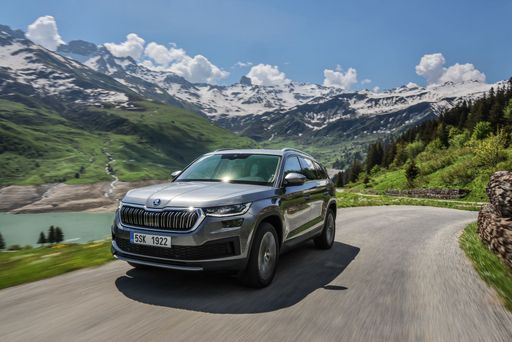 @ skoda-media.de
@ skoda-media.de
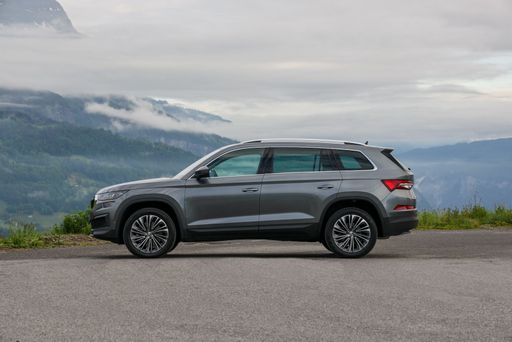 @ skoda-media.de
@ skoda-media.de
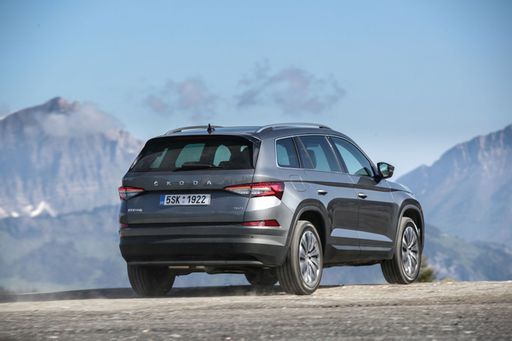 @ skoda-media.de
@ skoda-media.de
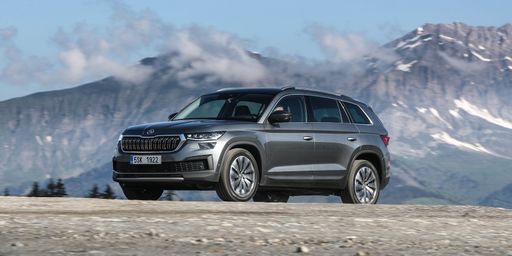 @ skoda-media.de
@ skoda-media.de
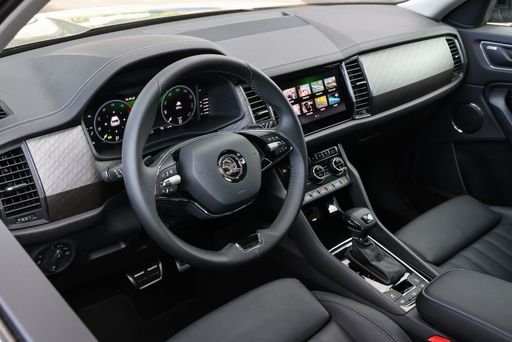 @ skoda-media.de
@ skoda-media.de
Toyota Mirai
The Toyota Mirai represents a groundbreaking step in hydrogen fuel cell technology, offering an eco-friendly alternative to traditional petrol engines. Its sleek design and futuristic aesthetic make it a standout on the road, while the interior combines comfort with cutting-edge features. With its impressive range and quick refuelling capabilities, the Mirai is paving the way for the future of sustainable motoring.
details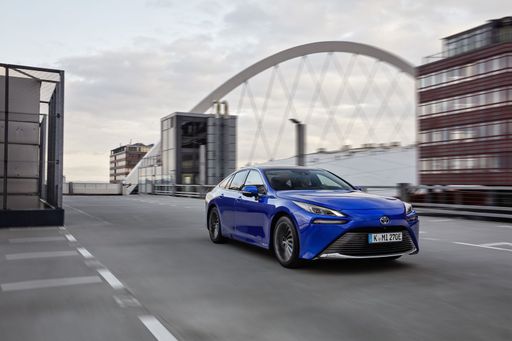 @ Toyota
@ Toyota

|

|
|
|
|
Costs and Consumption |
|
|---|---|
|
Price
36800 - 49600 £
|
Price
58700 - 66700 £
|
|
Consumption L/100km
0.4 - 8.2 L
|
Consumption L/100km
-
|
|
Consumption kWh/100km
-
|
Consumption kWh/100km
-
|
|
Electric Range
113 - 123 km
|
Electric Range
650 km
|
|
Battery Capacity
19.70 kWh
|
Battery Capacity
-
|
|
co2
9 - 186 g/km
|
co2
-
|
|
Fuel tank capacity
45 - 58 L
|
Fuel tank capacity
5 L
|
Dimensions and Body |
|
|---|---|
|
Body Type
SUV
|
Body Type
Sedan
|
|
Seats
5
|
Seats
5
|
|
Doors
5
|
Doors
4
|
|
Curb weight
1661 - 1913 kg
|
Curb weight
1900 - 1930 kg
|
|
Trunk capacity
745 - 910 L
|
Trunk capacity
300 L
|
|
Length
4758 - 4761 mm
|
Length
4975 mm
|
|
Width
1864 mm
|
Width
1885 mm
|
|
Height
1663 - 1683 mm
|
Height
1470 mm
|
|
Payload
497 - 538 kg
|
Payload
485 - 515 kg
|
Engine and Performance |
|
|---|---|
|
Engine Type
Plugin Hybrid, Petrol MHEV, Diesel, Petrol
|
Engine Type
Hydrogen
|
|
Transmission
Automatic
|
Transmission
Automatic
|
|
Transmission Detail
Automat. Schaltgetriebe (Doppelkupplung)
|
Transmission Detail
-
|
|
Drive Type
Front-Wheel Drive, All-Wheel Drive
|
Drive Type
Rear-Wheel Drive
|
|
Power HP
150 - 265 HP
|
Power HP
182 HP
|
|
Acceleration 0-100km/h
6.3 - 9.7 s
|
Acceleration 0-100km/h
9.20 s
|
|
Max Speed
205 - 231 km/h
|
Max Speed
175 km/h
|
|
Torque
250 - 400 Nm
|
Torque
300 Nm
|
|
Number of Cylinders
4
|
Number of Cylinders
-
|
|
Power kW
110 - 195 kW
|
Power kW
134 kW
|
|
Engine capacity
1498 - 1984 cm3
|
Engine capacity
-
|
General |
|
|---|---|
|
Model Year
2024 - 2025
|
Model Year
2021 - 2022
|
|
CO2 Efficiency Class
B, E, F, G
|
CO2 Efficiency Class
-
|
|
Brand
Skoda
|
Brand
Toyota
|
Skoda Kodiaq
The Skoda Kodiaq: An SUV at the Cutting Edge of Technology
The Skoda Kodiaq, a strikingly designed SUV, continues to impress with its blend of power, efficiency, and innovation. This popular model from Skoda combines advanced engineering with modern comforts, making it a favourite for families and adventurers alike. In this article, we'll delve into the technical details and innovations that make the Skoda Kodiaq a standout in the auto industry.
Powerful Performance Options
The Skoda Kodiaq offers a range of engine options to suit different driving preferences. From the efficient PlugIn-Hybrid models with up to 204 PS to the robust Diesel engines with up to 193 PS, drivers can choose the balance of power and efficiency that suits them. The performance is managed by an automatic transmission system, ensuring a smooth and responsive ride.
Innovation in Hybrid Technology
Skoda has taken significant strides in integrating hybrid technology into the Kodiaq. The PlugIn-Hybrid models boast an impressive electric range of up to 123 km, a testament to their efficient powertrain technology. Mild-Hybrid options are also available, offering a clever blend of petrol power with electrical assistance to reduce fuel consumption and emissions.
Comfortable and Spacious Interior
The Kodiaq's interior is designed with both luxury and practicality in mind. It offers ample space, with a boot capacity ranging from 745 to 910 litres, making it ideal for long journeys or family holidays. The vehicle's interior dimensions, complemented by a variety of high-tech features, ensure comfort and convenience for all passengers.
Advanced Safety Features
Safety is a top priority in the Skoda Kodiaq, with features such as advanced driver assistance systems, multiple airbags, and comprehensive stability controls. These technologies work together to provide drivers and passengers with peace of mind, whether on city streets or long motorway drives.
Impressive Fuel Efficiency
With fuel consumption rates as low as 0.4 L/100 km for hybrid versions, the Kodiaq sets high standards in terms of efficiency. Its Diesel counterparts also deliver competitive fuel economy. These efficient performances not only benefit your pocket but also contribute to reducing your carbon footprint.
Conclusion: A Blend of Efficiency and Power
In conclusion, the Skoda Kodiaq stands out with its combination of power, efficiency, and innovative technologies. With a variety of configurations to choose from, it is a vehicle that caters to diverse needs while ensuring an engaging driving experience. Whether it's the robust Diesel engines or the eco-friendly hybrid models, the Kodiaq continues to lead the way in the SUV segment.
Toyota Mirai
The Future of Driving: Introducing the Toyota Mirai
The Toyota Mirai represents a significant leap forward in automotive innovation, being one of the leading vehicles in the hydrogen fuel cell market. As we continue to search for sustainable transportation solutions, the Mirai stands out with its pioneering technology and exceptional driving features.
Revolutionary Hydrogen Fuel Cell Technology
At the heart of the Toyota Mirai is its groundbreaking hydrogen fuel cell system. Unlike conventional internal combustion engines, the Mirai uses a fuel cell stack to generate electricity through the chemical reaction between hydrogen and oxygen. This process not only powers the car with zero emissions—producing only water vapour as a byproduct—but also delivers a smooth and silent drive.
Technical Specifications and Performance
The Toyota Mirai is designed with performance in mind. It boasts a power output of 182 PS (134 kW) and delivers a robust 300 Nm of torque, allowing it to accelerate from 0 to 100 km/h in just 9.2 seconds. While its top speed is a respectable 175 km/h, it's the Mirai's impressive range that really stands out. The vehicle can travel up to 650 km on a single hydrogen fill-up, making it a practical choice for long-distance travel.
Sophisticated Design and Comfort
Designed as a saloon, the Toyota Mirai combines aesthetic appeal with comfort. Its dimensions—4975 mm in length, 1885 mm in width, and 1470 mm in height—provide a spacious interior for five passengers. The design is sleek and modern, reflecting its advanced engineering. The boot offers 300 litres of storage, suitable for everyday needs.
Advanced Features and Safety
The Toyota Mirai doesn't just excel in propulsion technology; it also includes a range of advanced features to enhance driver comfort and safety. Available in three trims—Advanced, Executive, and Luxury—the Mirai includes state-of-the-art safety systems and infotainment options to ensure a connected and secure driving experience.
Cost and Efficiency
While the price of the Toyota Mirai ranges from €65,990 to €76,290, its monthly running costs—estimated between €1,496 and €1,672—and per kilometre costs of 59.9 to 66.9 cents, reflect the efficient nature of hydrogen-powered vehicles. Considering its innovative technology, the Toyota Mirai offers excellent value for those looking to invest in the future of eco-friendly transport.
The Toyota Mirai: Driving Towards a Sustainable Future
Overall, the Toyota Mirai is more than just a car; it's a vision for the future of sustainable transportation. With its cutting-edge hydrogen fuel cell technology, impressive range, and commitment to zero-emissions driving, the Mirai sets a new standard in environmentally conscious car design. Whether you're an eco-enthusiast or just someone seeking a reliable and technological advanced vehicle, the Toyota Mirai is worth considering.
The prices and data displayed are estimates based on German list prices and may vary by country. This information is not legally binding.
